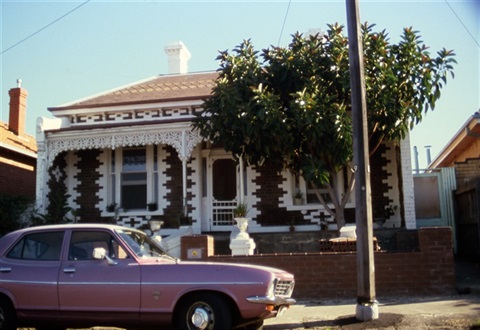19 Prospect Grove Northcote

19 Prospect Grove was built in 1887 by William John Carne. Named Pisgah it is a typical late Victorian double fronted brick house with a slate hipped roof. Pisgah is a Hebrew biblical reference meaning peak, height or cliff, no doubt referencing the location of the house on the top of the Northcote hill.
Carne passed away on the 25th November 1893, leaving his wife house and finances to the value of £2,238. Carne also left other money to be distributed amongst his children Mary Jane Sims, Ellen Joyce, James Baker Carne and Alfred Harris Carne.
Jane left the house four years later, apparently renting it out to a succession of tenants including Francis Edwards, John Holinger, William Stranaghan, William Freebairn, Thomas Turner and Walter Roe. It appears to have changed tenants pretty much yearly between 1893 and the 1910s. The rate books of 1900 still reflect Jane as the owner of the property.
Jane Carne passed away on the 21st June 1907 at the home of her daughter Ellen Joyce, 166 McKean Street North Fitzroy, aged 85.
During the 1920s and 1930s houses began to fill the gaps on the west side of Prospect Grove (the east side was still unbuilt on) and house numbers began to appear in the directories. The houses in Prospect Grove went through a dizzying array of street number changes and Pisgah was at times No. 6 and No. 8 before the street flipped to odd numbers about 1932. Pisgah became No. 17 and finally finished as being No. 19.
Throughout that time it went through a number of occupants including Charles Agnew, William Dempster and through the late 1930s August and Marie Zoller. Marie died at the house in September 1939.
By 1951 Leonard Baker and his wife Edith had moved into the house. Leonard worked as an electrician at a engineering company, Handley and Tilly in Victoria Street, Abbotsford. Prior to that the Bakers lived and worked in Kew where Leonard was probably at fruiterer. The Bakers lived at 19 Prospect Grove until at least 1972.
Although the house is largely untouched on the outside, the original timber capped picket fence was replaced with an unsympathetic brown brick fence in the 1970s.
WILLS AND ESTATES (1894, 22 January). The Age (Melbourne, Vic.: 1854 - 1954). p.3
FAMILY NOTICES (1939, 4 September). The Age (Melbourne, Vic.: 1854 - 1954). p.1
Sands and McDougall’s Melbourne and Suburban Directory 1864- 1974. [Microfiche]. (1974). Melbourne, Australia: Sands & McDougall